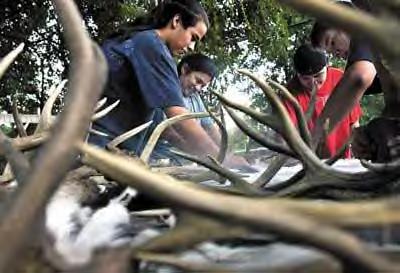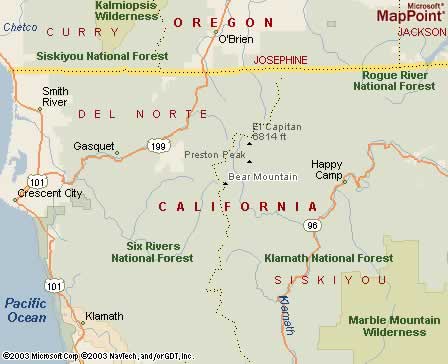|
|
Canku Ota |
|
|
(Many Paths) |
||
|
An Online Newsletter Celebrating Native America |
||
|
August 9, 2003 - Issue 93 |
||
|
|
||
|
Tribal History Permeates Air in the Valley |
||
|
by Laura Christman Record
Searchlight
|
||
|
credits: photo
by John Stubler: IN TOUCH WITH TRADITION: Arron Sisk, 16, left;
his mother, Caleen Sisk-Franco; James Ward, 15; and Tony Haase,
15, grind a deerskin. Skins and antlers were being prepared for
a Wintu dance that pays respect to deer. Sisk-Franco wants to keep
Wintu youth connected to their heritage. She hopes to rebuild a
Winemen village at the base of Bear Mountain, where she lives with
her family.
|
|
It was an area rich in food and spirituality. There were — and still are — sacred American Indian places in Jones Valley. Before the Europeans began to arrive in the 1850s, many Wintu and Yana lived along the Pit River, said archaeologist Elaine Sundahl, who has done work in the area for the U.S. Forest Service. Clikapudi Trail, an eight-mile dirt trail popular with mountain bikers, horseback riders and runners, gets its name from conflict between the two Indian groups. It means battleground, Sundahl said. Caleen Sisk-Franco, 50, of the Winemem band of the Wintu, said there were once 16 major villages near Bear Mountain. Bear Mountain is a spiritual mountain for us, Sisk-Franco said. Salt rocks, gathering sites and other places in the Jones Valley area also are sacred, she said. American Indians go to sacred places to pray, sing and seek courage or guidance. All are considered churches, even though there are no buildings there, said Mark Franco, 48, Sisk-Franco's husband. Sisk-Franco said it's important to keep the American Indian religion and traditions alive. She learned them from her grandmother, Florence Jones, 96, the spiritual leader of the Winemem. Jones was born on the McCloud River. She moved to Jones Valley in the 1930s and brought the ways of her people — practiced for hundreds of years — with her. She and her late husband, Andy, built a home at the base of Bear Mountain in 1950. It was nothing but manzanita, Jones recalls. Me and my husband cleared it and I said, 'I want my house right here.' She still lives in the house on a 42-acre piece of land. Sisk-Franco and 15 other family members also live on the property. Sisk-Franco feels fortunate the American Indian traditions have remained in the family. We have never been disconnected. That line of knowledge has never been broken, she said. American Indian culture is more than attending a powwow or displaying baskets, Sisk-Franco said. It's based on the way you live. It's based on religious practice. Her hope is to establish a Winemem village on her family's property so that the ways of the Winemem continue. We're trying to make this a major village. We hope that all 120 members (of the Winemem band) will be able to live here again, she said. Assimilating with the rest of society has been difficult for many American Indians, Sisk-Franco said. They suffer from high rates of diabetes, alcoholism and other problems, she said. The most we have done is hurt ourselves, trying to live in a different type of society, she said. What I want to do is bring our people back . . . so they know who they are and have a strong foundation. |
|
|
www.expedia.com |
|
|
||
|
|
||
| Canku Ota is a free Newsletter celebrating Native America, its traditions and accomplishments . We do not provide subscriber or visitor names to anyone. Some articles presented in Canku Ota may contain copyright material. We have received appropriate permissions for republishing any articles. Material appearing here is distributed without profit or monetary gain to those who have expressed an interest. This is in accordance with Title 17 U.S.C. Section 107. | ||
|
Canku Ota is a copyright © 2000, 2001, 2002, 2003 of Vicki Lockard and Paul Barry. |
||
 |
 |
|
|
The "Canku Ota - A Newsletter Celebrating Native America" web site and its design is the |
||
|
Copyright © 1999, 2000, 2001, 2002, 2003 of Paul C. Barry. |
||
|
All Rights Reserved. |
||
 The
Jones Valley area, with creeks and rivers thick with fish and
oak trees loaded with acorns, was an important place for American
Indians.
The
Jones Valley area, with creeks and rivers thick with fish and
oak trees loaded with acorns, was an important place for American
Indians. 